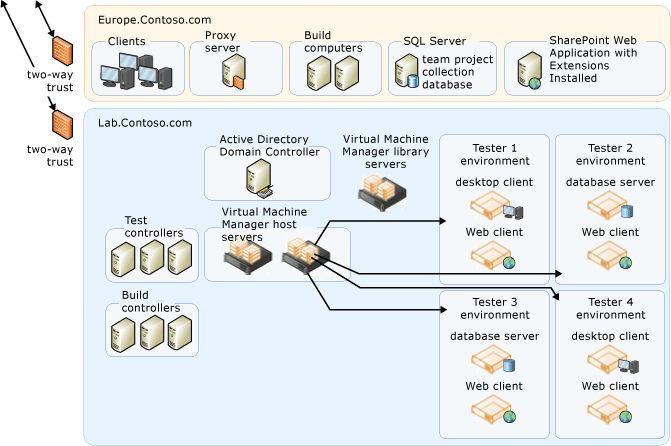Examples of complex topology for Azure DevOps Server
Azure DevOps Server 2022 | Azure DevOps Server 2020 | Azure DevOps Server 2019 | TFS 2018
You can configure Azure DevOps Server in one of several topology configurations. Generally speaking, the simpler the topology, the more easily you can maintain an Azure DevOps Server deployment. You should deploy the simplest topology that meets your business needs.
This article describes two complex Azure DevOps Server topologies. A complex topology has Azure DevOps Server components distributed across many servers. It is accessed by clients in multiple domains in geographically distant physical locations. Azure DevOps Proxy Server is installed in addition to optional components such as SharePoint Products and SQL Server Reporting Services. There are several different code bases, and these code bases each have their own project collection for the projects that use them. The databases for team project collections are stored on several different servers that are running SQL Server.
Complex single-domain topology
A complex server topology uses multiple servers in clusters or other failover configurations to host the logical Azure DevOps data and application tier components. The following diagram demonstrates a complex single-domain topology:

This example topology is similar to the moderate topology. Azure DevOps Server services are deployed on one server and the Azure DevOps Server databases are installed on a separate server, with Team Foundation Build and the team's test agents and test agent controllers deployed on additional servers. Also, fail-over components have been added. The Azure DevOps databases have been installed on a SQL Server cluster.
The example diagram shows child domains in Seattle and Cleveland, each with a two-way transitive trust to the parent domain. The service account for Azure DevOps Server is trusted by both domains. Each geographically distant child domain uses a limited-bandwidth connection. Since getting an enlistment from the version code control component of Azure DevOps Server can take a very long time under such limited bandwidth conditions, an Azure DevOps Proxy Server is installed in each child domain to act as a version control file proxy cache. All client requests go directly to the application tier, with the exception of version control code get requests. These requests are directed through the Azure DevOps Proxy Server, which then caches all source files that it downloads on the proxy server.
The topology in this example is also concerned with fault tolerance and high performance. Data tier fault tolerance is provided by taking advantage of the SQL Server clustering technologies. Multiple SharePoint Web applications are configured for use by projects within collections in a SharePoint Web farm. Project collection databases are distributed across SQL Server instances for improved performance and ease of individual management. SQL Server Reporting Services and SQL Server Analysis Servers are running on separate servers for improved performance.
This example is designed for a large product development team with up to 2,000 users.
Complex multi-domain topology
A complex multi-domain server topology uses multiple servers in two or more domains. As with the complex single-domain topology, the deployment uses clusters or other failover configurations to host the components of the data tier for Azure DevOps. The administrators for this deployment have configured network load balancing and added multiple application-tier servers to distribute the operational load. The following illustration demonstrates a complex multi-domain topology:


As in the above example, this topology is configured for fault tolerance and high performance. In addition, this topology is distributed across multiple domains, some of which are fully trusted child domains of the parent domains, but one of which (IsolatedLab.com) is a completely separate domain. The service accounts used by Azure DevOps Server are fully trusted members of all domains, and user accounts have been configured in both the parent domain and the separate domain as necessary for users who must work in both domains. Firewalls have been configured to allow traffic across the ports required by Azure DevOps Server.